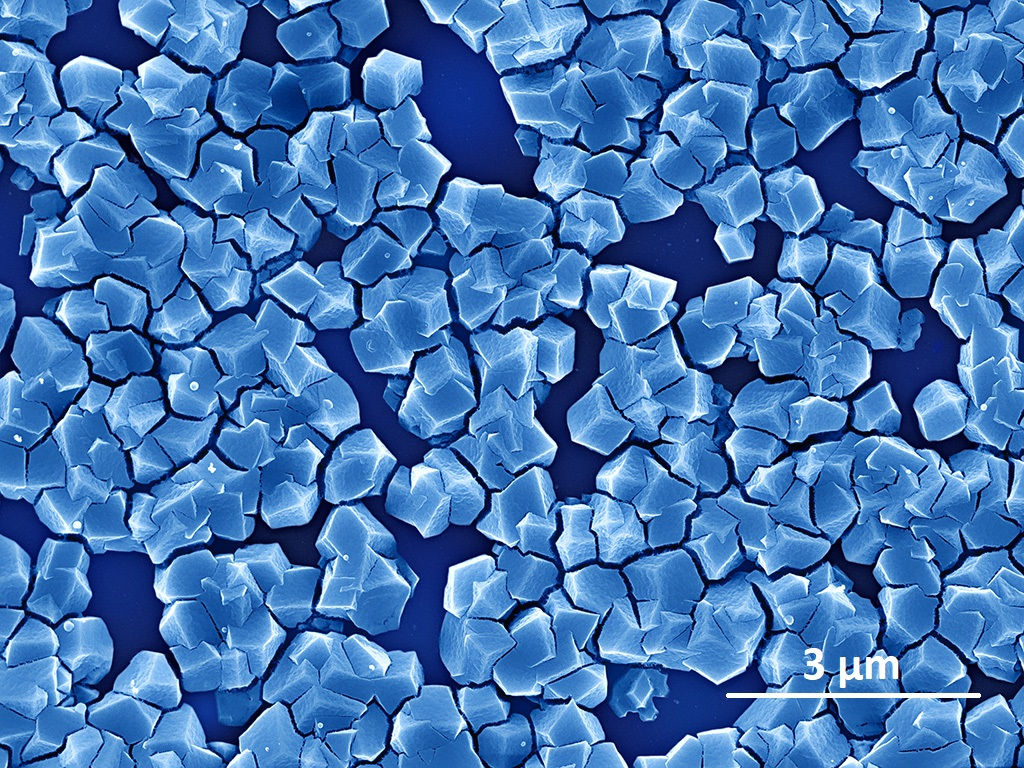Images de science: new materials to trap or screen molecules
This image was taken during the formation of a membrane of ultraporous material, which allows molecules to be "sieved" or trapped. These materials are being developed for separating gas mixtures, cleaning up air or water, or delivering active drug ingredients more efficiently.
Martin Drobek, University of MontpellierAnne JULBE, University of Montpellier and Didier Cot, University of Montpellier

These materials are composed of elementary bricks that form impressively diverse meshes. The bricks can be assembled like a "Lego set" on the nanometric scale.
They are made up of metal ions linked together by organic molecules acting as cement and spacer. These networks, known as "metal organic frameworks " (MOFs), enable the formation of a virtually unlimited number of molecular structures with adjustable physical and chemical properties. Some "MOFs" can accommodate and transport small gas molecules, such as hydrogen, while others can trap and release large molecules, such as active drug ingredients.
Their hybrid nature, both organic and inorganic, gives "MOFs" a highly flexible structure. Their extremely high porosity, with a mesh of small, regular, well-ordered pores, explains their low density and large accessible internal surface area, the size of a soccer pitch for a single gram of material! Such a surface area - several thousand square meters - far exceeds that of reference porous materials such as zeolites or activated carbons.
Most "MOFs" are, by default, prepared and used in powder form, but to fully exploit their applicative potential on a large scale and at industrial level, "shaping", e.g. into granules or thin films, is generally required, and production costs must be competitive.
Screening molecules through a highly selective porous network
At the European Membrane Institute in Montpellier, we are focusing on these materials for the development of membranes that can separate gas mixtures through a "molecular sieving" effect. Deposited on the surface of gas sensors, such membranes can improve the selectivity of toxic or explosive gas detection, thanks to their preferential transport in the pores.
By modulating the length of the organic molecules linking the metal centers, pore size can be adjusted. The majority of "MOFs" are microporous (pore diameter less than 2 nanometers) and their pores can accommodate and transport, in addition to hydrogen, other small gas or vapor molecules such as water, oxygen or carbon dioxide.
We are currently focusing on hydrogen sensors, in view of the safety issues raised by the production, transport, storage and use of this gas. The strategy consists in coating the sensitive sensor material with a layer of a specific type of "MOFs". The separating effect of this molecular sieve allows hydrogen to diffuse easily into the sensor, while rejecting the other gases in the mixture.
Trapping molecules like cages
However, given the diversity of possible structures and functionalities, the field of application for "MOFs" is much wider. Indeed, their pores match the dimensions of a wide variety of common molecules, and they can be used as nano-cage sponges for the selective adsorption of these molecules.
Mesoporous "MOFs " (diameter greater than 2 nanometers) are also of interest for these applications. Their main advantage lies in the possibility of using them to encapsulate large molecular systems, such as proteins or drugs, nanoparticles or "macromolecular" assemblies (groupings of giant molecules).
We can therefore envisage the development of complex architectures such as "MOFs". to store and produce energydepollute the air or water by the selective adsorption of harmful compounds; or in the healthcare field, for example for the controlled distribution of active ingredients.![]()
Martin Drobek, CNRS Research Fellow, University of MontpellierAnne JULBE, CNRS Research Director, specialist in ceramic and hybrid membranes, University of Montpellier and Didier Cot, engineer, head of the electron and photonic microscopy unit, European Membrane Institute, University of Montpellier
This article is republished from The Conversation under a Creative Commons license. Read theoriginal article.